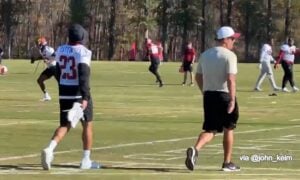Raise your hand if you are among those who is in support of the idea of the NFL expanding the gameday active roster beyond the 46 players among the 53-man roster that are allowed to dress and play during games each week. Get your hands up there so we can see you.
Now ball your fist and pump it, because you just got your champion, and his name is Dan Quinn, the head coach of the Atlanta Falcons. And just to sweeten that pot a little bit, the Falcons’ president and CEO, Rich McKay, is the sitting chairman of the Competition Committee. That’s a big dot to connect.
During the winding moments of the Annual League Meeting from last week, Quinn told reporters that he would hope someday to see the ability for him to field more active players for games. “If I had to say one thing how do we do it better, I would say I hope at some point we expand the rosters to get even bigger”, he said. “No pressure if a guy is out to say, ‘okay, here’s another guy that’s up’”.
As it currently stands, each team is required to declare seven players to serve as gameday inactives, meaning that they do not dress in uniforms as games are played and they are not permitted to participate, though they can be on the sidelines.
The thought process behind the inactive list dates back to a time further back in the history of the game, and of the league, when there were more imbalanced and smaller rosters, and the inactive members of the teams were a mechanism that was intended to create balance between two competing sides to compensate for one team having more injured players than another.
“So 46 is good. And maybe in years to come, 10 years from now when we’re sitting here, ‘okay, remember back in the day when you had 46 guys?’”, he said. “Maybe it goes to 50 or something along those lines and gets more opportunities for guys because without a developmental league, we’re hopeful that maybe the roster size gains by a few spots, that we can incorporate that. And I think it’d be safer, too, to have more guys available to play”.
The latter point is one that proponents of this argument frequently bring up, because having a more limited number of bodies is more likely to expose an injured player to playing time that he might not otherwise have to indulge if the team were able to field more players at his position.
I know there are more recent examples, but one that always comes to mind is one game during his rookie season in which Marcus Gilbert had to re-enter a game after injuring his shoulder because his backup suffered a worse injury.
The same article from which the Quinn quotes were taken also quotes McKay as saying that roster size is a topic that typically is discussed on a yearly basis. Cleveland Browns head coach Hue Jackson also voiced his support for expanded rosters. This is one movement that I hope builds steam in the coming years.








